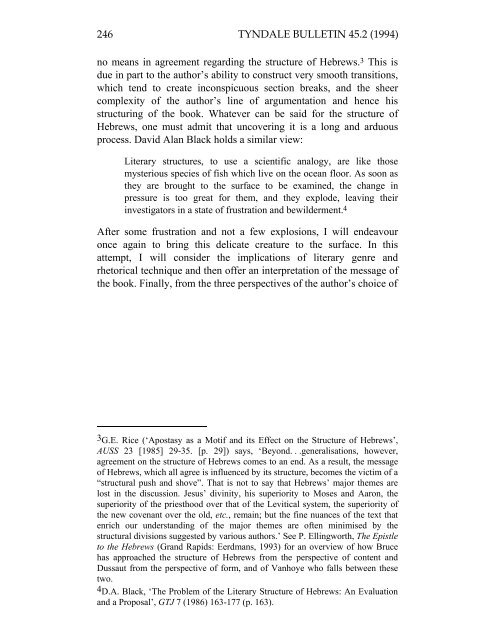the structure of hebrews from three perspectives - Tyndale House
the structure of hebrews from three perspectives - Tyndale House
the structure of hebrews from three perspectives - Tyndale House
You also want an ePaper? Increase the reach of your titles
YUMPU automatically turns print PDFs into web optimized ePapers that Google loves.
246 TYNDALE BULLETIN 45.2 (1994)<br />
no means in agreement regarding <strong>the</strong> <strong>structure</strong> <strong>of</strong> Hebrews. 3 This is<br />
due in part to <strong>the</strong> author’s ability to construct very smooth transitions,<br />
which tend to create inconspicuous section breaks, and <strong>the</strong> sheer<br />
complexity <strong>of</strong> <strong>the</strong> author’s line <strong>of</strong> argumentation and hence his<br />
structuring <strong>of</strong> <strong>the</strong> book. Whatever can be said for <strong>the</strong> <strong>structure</strong> <strong>of</strong><br />
Hebrews, one must admit that uncovering it is a long and arduous<br />
process. David Alan Black holds a similar view:<br />
Literary <strong>structure</strong>s, to use a scientific analogy, are like those<br />
mysterious species <strong>of</strong> fish which live on <strong>the</strong> ocean floor. As soon as<br />
<strong>the</strong>y are brought to <strong>the</strong> surface to be examined, <strong>the</strong> change in<br />
pressure is too great for <strong>the</strong>m, and <strong>the</strong>y explode, leaving <strong>the</strong>ir<br />
investigators in a state <strong>of</strong> frustration and bewilderment. 4<br />
After some frustration and not a few explosions, I will endeavour<br />
once again to bring this delicate creature to <strong>the</strong> surface. In this<br />
attempt, I will consider <strong>the</strong> implications <strong>of</strong> literary genre and<br />
rhetorical technique and <strong>the</strong>n <strong>of</strong>fer an interpretation <strong>of</strong> <strong>the</strong> message <strong>of</strong><br />
<strong>the</strong> book. Finally, <strong>from</strong> <strong>the</strong> <strong>three</strong> <strong>perspectives</strong> <strong>of</strong> <strong>the</strong> author’s choice <strong>of</strong><br />
3G.E. Rice (‘Apostasy as a Motif and its Effect on <strong>the</strong> Structure <strong>of</strong> Hebrews’,<br />
AUSS 23 [1985] 29-35. [p. 29]) says, ‘Beyond. . .generalisations, however,<br />
agreement on <strong>the</strong> <strong>structure</strong> <strong>of</strong> Hebrews comes to an end. As a result, <strong>the</strong> message<br />
<strong>of</strong> Hebrews, which all agree is influenced by its <strong>structure</strong>, becomes <strong>the</strong> victim <strong>of</strong> a<br />
“structural push and shove”. That is not to say that Hebrews’ major <strong>the</strong>mes are<br />
lost in <strong>the</strong> discussion. Jesus’ divinity, his superiority to Moses and Aaron, <strong>the</strong><br />
superiority <strong>of</strong> <strong>the</strong> priesthood over that <strong>of</strong> <strong>the</strong> Levitical system, <strong>the</strong> superiority <strong>of</strong><br />
<strong>the</strong> new covenant over <strong>the</strong> old, etc., remain; but <strong>the</strong> fine nuances <strong>of</strong> <strong>the</strong> text that<br />
enrich our understanding <strong>of</strong> <strong>the</strong> major <strong>the</strong>mes are <strong>of</strong>ten minimised by <strong>the</strong><br />
structural divisions suggested by various authors.’ See P. Ellingworth, The Epistle<br />
to <strong>the</strong> Hebrews (Grand Rapids: Eerdmans, 1993) for an overview <strong>of</strong> how Bruce<br />
has approached <strong>the</strong> <strong>structure</strong> <strong>of</strong> Hebrews <strong>from</strong> <strong>the</strong> perspective <strong>of</strong> content and<br />
Dussaut <strong>from</strong> <strong>the</strong> perspective <strong>of</strong> form, and <strong>of</strong> Vanhoye who falls between <strong>the</strong>se<br />
two.<br />
4D.A. Black, ‘The Problem <strong>of</strong> <strong>the</strong> Literary Structure <strong>of</strong> Hebrews: An Evaluation<br />
and a Proposal’, GTJ 7 (1986) 163-177 (p. 163).
















